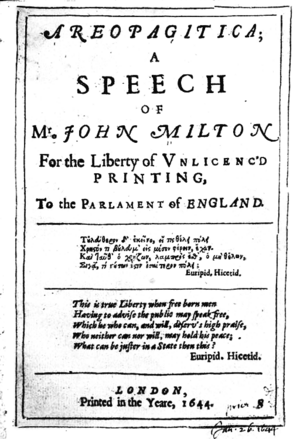Licensing Order of 1643 facts for kids
The Ordinance for the Regulating of Printing, also known as the Licensing Order of 1643, was a law that brought back censorship in England during the time of Parliament's rule. This meant that books and other writings had to be approved before they could be published. The famous writer John Milton wrote his book Areopagitica specifically to argue against this law.
Contents
End of the Star Chamber Court
The Star Chamber was a special court in England. It was used by the King to control many things, including what people could print. In July 1641, Parliament passed the Habeas Corpus Act 1640. This law got rid of the Star Chamber.
When the Star Chamber was removed, it meant that rules about printing became much looser. This led to a huge increase in the number of things being published. Between 1640 and 1660, over 300 different news publications were created!
The Licensing Order of 1643

Even though Parliament got rid of the Star Chamber, it didn't mean they wanted complete freedom of speech or printing. Instead, Parliament wanted to control what was printed themselves, rather than the King doing it.
Parliament created a new system to control printing. This was called An Ordinance for the Regulating of Printing. It was put into effect on June 14, 1643. Parliament wanted to:
- Stop confusion and illegal copying in the printing business.
- Protect their own activities from opponents.
- Stop messages from people who supported the King.
- Control new, radical ideas from different groups.
The Licensing Order brought back many strict rules that were similar to older laws. These rules included:
- All printed materials needed a special license (permission) before they could be published.
- The names of the author, printer, and publisher had to be officially recorded.
- Government officials could search for, take, and even burn any books they found offensive.
- Writers, printers, and publishers who broke the rules could be arrested and put in prison.
The Stationers’ Company, a group of printers and booksellers, was given the job of being the censor. In return, they had the only right to print things.
Milton's Areopagitica
As a protest against this new law, the English poet and writer John Milton published his famous work Areopagitica: A speech of Mr. John Milton for the Liberty of Unlicenc'd Printing, to the Parlament of England. He released it in November 1644, about 16 months after the Licensing Order began.
Printing Rules After the King Returned
After the monarchy (the King) was restored in the 1660s, even stricter rules were put on printing. One person was given the power to publish the official newspaper. This person was also in charge of censoring all other publications.
1695: The Licensing Order Ends
After the Glorious Revolution of 1688, William and Mary became King and Queen. They agreed to the terms in the Declaration of Rights. This document became an important part of Britain's "constitution." American patriots later used it to explain their own freedoms.
The Licensing Order was allowed to end on April 17, 1695. The House of Commons decided not to renew it. They said the law "in no-wise answered the End for which it was made." This means the law didn't work as intended.
Historians say the law ended not because it took away people's freedoms, but because it gave too much control to the King and a small number of booksellers. The reasons for ending the law were more about business than about rights.
Even though many people say the "Licensing Act expired in 1695," it wasn't just forgotten. The freedoms created by the Declaration of Rights led to a more open society. This caused a huge increase in printing!
The number of printing shops in England grew from 20 in 1695 to 103 by 1724 (75 of them were in London). In England, new publications like the Tatler and the Spectator helped create a public space for sharing ideas and information freely. In the American colonies, the end of the Licensing Act also led to many new publications. This set the stage for the arguments that led to the American Revolution later on.
See also
- UK constitutional law
- Copyright
- Licensing of the Press Act 1662
- Statute of Anne, 1709

